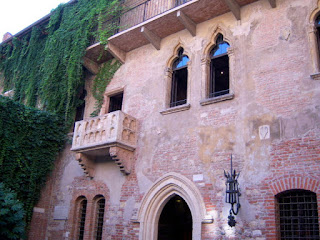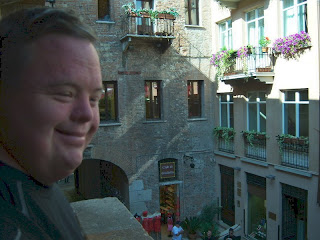During World War I, there was horrendous fighting in these Alps. From 1915 to 1917, Italians and Austrians suffered two winters, dug in, tunneling, in trenches, and with mines. There were 6400 Italians killed, 1800 Austrians, for example, at one battle alone. See Dolomites, History, at ://www.dolomiti.org/dengl/sd/index.html/. That was at Col de Lana, and col means "pass". We did not know of the tunnel tangle at Lagazuoi, the Ice City, but if we get back, that will be on the list. See it at ://www.dolomiti.org/dengl/Cortina/laga5torri/storia/fronteLaga.html
The town and region of Cortina is now a UNESCO World Heritage site, see http://italy-travel.suite101.com/article.cfm/italian_dolomites_alpine_driving_tour/, famous for its sports, partying and also its long strategic history, see ://www.dolomiti.org/dengl/Cortina/csto/mfbelli/index.html/ In 1956, Cortina d'Ampezzo hosted the Olympics. Read the index of topics at that site: prehistoric times, Romans, Middle Ages with the Lombards, Franks and then the Ottomans, nobles and Crusades, Venice influence, short-lived small republic (Maximilian let that go on a while), jump ahead to Fascism and World Wars, and boundary shifts.
Travel is restricted. Plan for it.
We arrived at Cortina from the north, from Lienz, Austria; then tried to get to Merano
from Cortina.
Merano used to be part of Austria as Meran, and a dear friend's grandfather was from the old town. We were caught in the wrong place, wrong time. Too far to go to head back to the long valley route, and the mountain passes are impassible unless you start early in the day, plan to creep about, check the map every turn (signs are for passes and choices in passes, not the ultimate town heading for), and a full tank. Plan your time in the Dolomites so you see the topography, not just the distances. Ranges go north-south, and passes letting you go east-west are one hazardous switchback after another, on a 1 1/2 lane road, if that, with some lay-bys, otherwise you back up. So plan accordingly.
See that Italian Dolomites Alpine Driving Tour site for how to get to Cortina, and other places, from Verona. Plan to go from the south.
As you go, watch for those WWI memorials.
 Juliet's house and balcony (ersatz), Verona, Italy
Juliet's house and balcony (ersatz), Verona, Italy Juliet Herself, with Daniel, the restrained Admirer, Verona, Italy
Juliet Herself, with Daniel, the restrained Admirer, Verona, Italy The
The  It happened in Verona, Italy.
It happened in Verona, Italy. Dolomites, Italian Alps
Dolomites, Italian Alps Cortina, Dolomites, Italian Alps
Cortina, Dolomites, Italian Alps